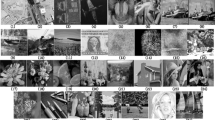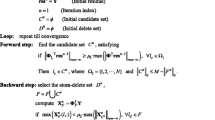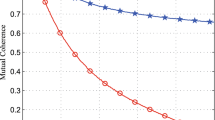Abstract
Developed in recent years, compressed sensing (CS) has saved considerable data storage and time in signal acquisition and processing, drawing the attention of many scholars in various fields. At present, a key issue is the design of an effective CS reconstruction algorithm. Unlike the commonly used CS convex optimization approaches, which require determining the direction first and later using the linear search to attain the optimal displacement, the trust region method introduced into the CS model in this paper solves a quadratic convex optimization problem in the varied circular area. The simulated reconstruction of two-dimensional images is performed via MATLAB. Meanwhile, comparative analysis is executed using different CS reconstruction methods, such as the greedy algorithms (orthogonal matching pursuit, sparse adaptive matching pursuit) and convex optimization algorithms (basis pursuit, conjugate gradient). The experimental results are summarized and analyzed, demonstrating that the proposed CS trust region method may recover the images more accurately than state-of-the-art schemes.






Similar content being viewed by others
References
C. Bilen, G. Puy, R. Gribonval, L. Daudet, Convex optimization approaches for blind sensor calibration using sparsity. IEEE Trans. Inform. Theory 62(18), 4847–4856 (2014)
S.S. Cai, J.W. Zhang, D.H. Feng, M. Bao, Improved regularized orthogonal matching pursuit method used in estimation of directions of arrival. Acta Acust. United Ac. 39(1), 35–41 (2014)
E.J. Candés, The restricted isometry property and its implications for compressed sensing. C. R. Math. 346(9–10), 589–592 (2008)
E.J. Candés, T. Tao, Near optional signal recovery from random projections: universal encoding strategies. IEEE Trans. Inform. Theory 52(12), 5406–5425 (2006)
J.S. Chen, The semismooth-related properties of a merit function and a descent method for the nonlinear complementarity problem. J. Glob. Optim. 36(4), 565–580 (2006)
W. Dai, O. Milenkovic, Subspace pursuit for compressive sensing signal reconstruction. IEEE Trans. Inform. Theory 55(5), 2230–2249 (2009)
W. Dan, R.H. Wang, Robustness of orthogonal matching pursuit under restricted isometry property. Sci. China Math. 57(3), 627–634 (2014)
D.L. Donoho, Compressed sensing. IEEE Trans. Inform. Theory 52(4), 1289–1306 (2006)
H.T. Fabich, M. Benning, A.J. Sederman, D.J. Holland, Ultrashort echo time (UTE) imaging using gradient pre-equalization and compressed sensing. J. Magn. Reson. 245, 116–124 (2014)
A.C. Gilbert, S. Muthukrishnan, M.J. Strauss, Improved time bounds for near optimal sparse Fourier representations, in Proceedings of SPIE, Wavelets XI[C], vol. 5914 (International Society for Optical Engineering, Bellingham, 2005), pp. 1–15
M.R. Hestenes, Multiplier and gradient methods. J. Optim. Theory Appl. 4, 303–320 (1969)
B.X. Huang, T. Zhou, Recovery of block sparse signals by a block version of StOMP. Signal Process. 106, 231–244 (2015)
X.L. Huang, Y.P. Liu, L. Shi, V.H. Sabine, J.A.K. Suykens, Two-level \(l_{1}\) minimization for compressed sensing. Signal Process. 108, 459–475 (2015)
C. Kanzow, Some noninterior continuation methods for linear complementarity problems. SIAM J. Matrix Anal. Appl. 17, 851–868 (1996)
S.J. Kim, K. Koh, M. Lustig, D. Gorinevsky, A method for large scale regularized least squares. IEEE J. STSP 4(1), 606–617 (2007)
P.T. Lauzier, J. Tang, G.H. Chen, Prior image constrained compressed sensing: implementation and performance evaluation. Med. Phys. 39(1), 66–80 (2012)
H.F. Li, Y.L. Fu, Q.H. Zhang, R. Rong, A generalized hard thresholding pursuit algorithm. Circuits Syst. Signal Process. 33(4), 1313–1323 (2014)
S.L. Li, K. Liu, F. Zhang, L. Zhang, L.L. Xiao, D.P. Han, Innovative remote sensing imaging method based on compressed sensing. Opt. Laser Technol. 63, 83–89 (2014)
Y.B. Liu, N. Li, R. Wang, Y.K. Deng, Achieving high quality three dimensional InISAR imageries of maneuvering target via super-resolution ISAR imaging by exploiting sparseness. IEEE Geosci. Remote Sens. 11(4), 828–832 (2014)
Y.W. Liu, J.F. Hu, A neural network for l1-l2 minimization based on scaled gradient projection: application to compressed sensing. Neurocomputing 173, 988–993 (2015)
W.T. Lv, J.F. Wang, W.X. Yu, Z. Tan, Improvement of semi-random measurement matrix for compressed sensing. IEICE Trans. Fundam. Electron. E97A(6), 1426–1429 (2014)
A. Majumdar, R.K. Ward, T. Aboulnasr, Algorithms to approximately solve NP hard row-sparse MMV recovery problem: application to compressive color imaging. JETCAS 2(3), 362–369 (2014)
D. Needell, J.A. Tropp, CoSaMP: iterative signal recovery from incomplete and inaccurate samples. Commun. ACM 26(3), 301–321 (2009)
T.T. Qiao, W.G. Li, B.Y. Wu, A new algorithm based on linearized bregman iteration with generalized inverse for compressed sensing. Circ. Syst. Signal Process. 33(5), 1527–1539 (2014)
Sanjit K. Mitra, Digital Signal Processing (McGraw-Hill Science/Engineering/Math, New York, 2005)
D. Sundman, S. Chatterjee, M. Skoglund, Distributed greedy pursuit algorithms. Signal Process. 105, 298–315 (2014)
J.G. Yang, T. Jin, X.T. Huang, J. Thompson, Z.M. Zhou, Sparse MIMO array forward-looking GPR imaging based on compressed sensing in clutter environment. IEEE Trans. Geosci. Remote 52(7), 4480–4494 (2014)
Acknowledgments
This investigation is supported by the National Natural Science Foundation of China under Grant Nos. 61202051 and 41371422 and supported by the Special Fund for Basic Scientific Research of Central Colleges, China University of Geosciences (Wuhan) under Grant No. CUG130416.
Author information
Authors and Affiliations
Corresponding author
Rights and permissions
About this article
Cite this article
Wang, Y., Xiang, X., Zhou, S. et al. Compressed Sensing Based on Trust Region Method. Circuits Syst Signal Process 36, 202–218 (2017). https://doi.org/10.1007/s00034-016-0299-2
Received:
Revised:
Accepted:
Published:
Issue Date:
DOI: https://doi.org/10.1007/s00034-016-0299-2




